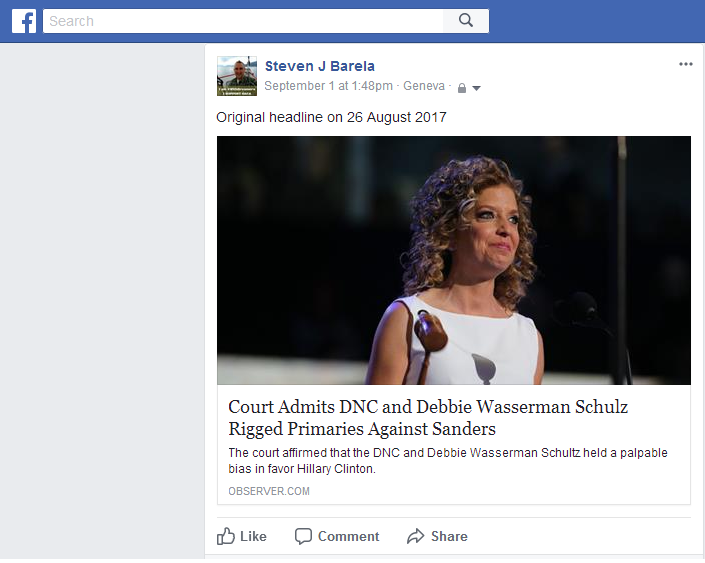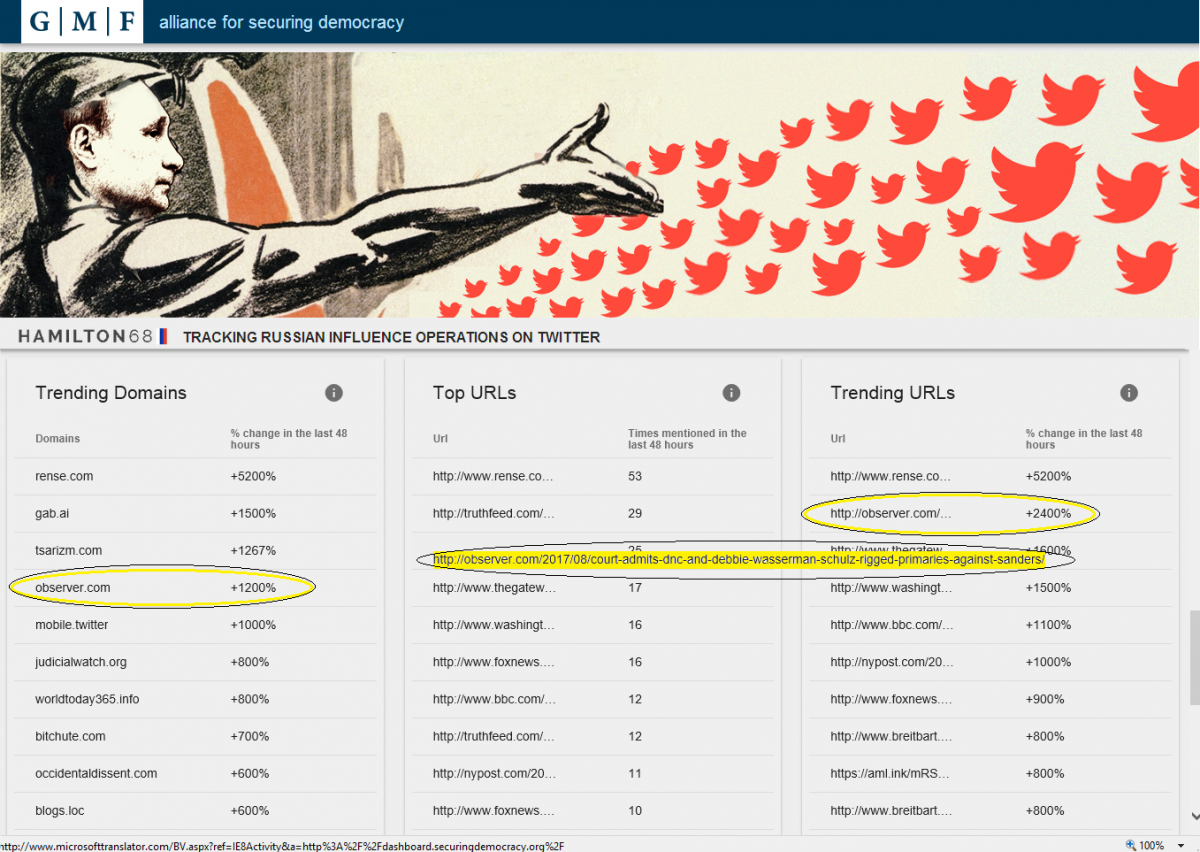
In January I wrote a piece that explored the international law principle of non-intervention in the context of what had just become known with the release of the Russian Activities Report on interference in the 2016 election. Simply put, an intervention into the domaine réservé must rise to the level of coercion to be deemed unlawful (Tallinn Manual 2.0, Rule 66). Some have suggested the better legal rubric would be that of self-determination, while others pursue the right to privacy violations in domestic US law (also a violation in human rights law). Nevertheless, in addition to this valuable debate on the law, we must also keep an eye on the evolving and emerging facts for this case to determine if it can indeed be classified as coercive—an undefined term in international law. In this regard, information exfiltrated from the Democratic National Committee (DNC) by Russia continues to make its way through U.S. courts and the media landscape, and on occasion we can find it being distorted to sow discord. At the very same time, bots (automated scripts) and trolls (paid social media actors) that are linked to Russia have worked to amplify its presence in social media. To wit, the meddling in US democracy by proliferating disinformation to divide Democrats continues by Russia.
Propagating a Narrative at the 2016 DNC Convention
The first palpable victim of the Russian campaign in 2016 came when former DNC Chairperson, Debbie Wasserman Schultz, was forced to announce her intention to step down after the national convention in July of last year. In the days before the event, Wikileaks had posted material online that had been pilfered from the DNC.
Most pertinent at that moment was the fact that this revealed some bias by Wasserman Shultz and others in the DNC during the primary elections in favor of presidential candidate Hillary Clinton over Bernie Sanders. A great raucous broke out at the opening of the convention as Sanders supporters were upset to learn of evidence that confirmed their suspicions. Yet others have contended that the contest was never in contention. One well-respected statistician, Nate Silver, concluded after looking at the numbers and giving due regard to all that Bernie Sanders had achieved: “My view is that the race wasn’t really all that close and that Sanders never really had that much of a chance at winning.”
Regardless of the veracity or inaccuracy of each claim, US military officers have recently noted that Russian dezinformatsiya—or disinformation campaigns—are “designed to stoke chaos” and spread “dissatisfaction among the population.” We can readily see that this leak of stolen material did exactly that. The “Guccifer 2.0” operation (a front for Russian hackers) was used to drive a wedge into an already existing rift within the Democratic Party as some felt that the system had been fixed against their popular candidate. For them, these published emails verified their belief and they got their scalp in Wasserman Schultz.
While this episode is significant to the Russia interference before the election, this same exfiltrated material, and very same wedge, continues to be exploited. In essence, the full effects of this cyber-attack through the weaponization of information have not come to a close.
A Class Action Lawsuit
Just two weeks after the first disclosure of documents from Guccifer 2.0 (even before the Wikileaks release in July), a class action lawsuit was filed in federal district court in southern Florida and announced via YouTube. The case was brought on behalf of all people who had donated to the DNC, those who contributed to the Sanders campaign and all registered members of the Democratic Party. The claim was that Debbie Wasserman Shultz and the party establishment was in cahoots with the Clinton campaign and sought to tip the scales in her favor. While there is reason to believe that this lawsuit was a genuine grassroots effort, the case was indeed built on the cyber-poached documents from a Russian operation. One expert who testified before the Senate Intelligence Committee in March, Thomas Rid, explained how this now works: “Cold War disinformation was artisanal; today it is outsourced, at least in part—outsourced to the victim itself.”
This story recently took an important turn as a summary judgment for final order of dismissal of the case was handed down on August 25th. The presiding judge decided it was clearly demonstrated that a trial was unnecessary because: 1) the court lacked jurisdiction and 2) the Plaintiffs did not have standing to assert each of the causes of action. Reasonable reporting, or even sharp critique, would focus on these two questions since they are the crux of the legal issue.
Dezinformatsiya
Hours after the dismissal was handed down, an article was posted at the Observer with the inflammatory headline, “Court Admits DNC and Debbie Wasserman Schulz [sic] Rigged Primaries Against Sanders.” This particular media outlet had been covering the case since its filing and continued to do so here and here. In fact, it released a story claiming that the “Guccifer 2.0 Leak Reveals How DNC Rigged Primaries for Clinton” only two days after the disorderly cache of material was first dumped on June 15, 2016. Yet, the national uproar only took place in July after the more user-friendly Wikileaks release.
This focus and sustained attention on the issue by the Observer newspaper makes it worth pointing out that it had been owned by Jared Kushner up until last January. At that point, his brother-in-law took over as publisher and interest was transferred into a family trust in preparation for Kushner to take a position to work in the White House as a senior advisor to President Donald Trump.
Of most significance here is the misleading headline—insisting that the court ruled on a “rigging” of the election—which could be easily shared through social media (title has since changed to “Court Concedes DNC Had the Right to Rig Primaries Against Sanders”). Of course, at this stage of the proceedings the judge was obliged to assume as true all the claims put forward by the Plaintiff and only consider the technical matters of pleading and subject-matter jurisdiction—the requisite hurdles for a full trial.
As it happens, this incendiary headline has moved through Facebook communities of Bernie Sanders supports demonstrating the sophisticated targeting implemented:

In the original article, the author suggests that the summary judgment “reflects a dire state of democracy in this country … proving the DNC attorney’s claims that the DNC is within their right to rig primaries.” Despite this, the article does grudgingly note that at this stage there is an assumption that “a plaintiff’s allegation is inherently taken to be true.” (Be careful, the headline and content of this article changed more than once in the first week.)
If you follow the link in the article and read the judgment, the requirements of the proceedings have all been made explicitly clear by the judge:
“This Order does not concern who should have been the Democratic Party’s candidate for the 2016 presidential election; it does not concern whether the DNC or Wasserman Schultz generally acted unfairly towards Senator Sanders or his supporters; indeed, it does not even concern whether the DNC was in fact biased in favor of Hillary Clinton in the Democratic primaries. At this stage, the Court is required to construe the First Amended Complaint (DE 8) in the light most favorable to Plaintiffs and accept its well-pled allegations as true.” (p.8)
Much of the information in the article is true, so why does this qualify as dezinformatsiya? For one, the lawsuit itself is entirely based on the material pinched by Russia (p.4-6). Next, the changing title and content of the article leave the analyst and returning readers grasping for a moving substance that is difficult to fully understand or discuss. (Even if changed, the URL still reveals the original headline which continues to move through social media—see below.) Most importantly, we can see that the term “rigged” is consistently tied to the court’s judgment. Though this connection is demonstrably false, it is central to the narrative being propagated. As our expert Thomas Rid helpfully tweeted in May: “Historic note: Soviet bloc disinformation operators considered the best fact/forgery mix to be ~90% fact, ~10% fake.” Indeed, we can find a similar proportion of “real vs. fake” in this article.
Russian Bots and Trolls
Finally, we can uncover further Russian involvement in this operation today. To do so an extremely useful tool was unveiled at the beginning of August: Hamilton 68. This new website tracks in real time Russian propaganda on Twitter and was a project spearheaded by a former FBI special agent, Clint Watts (who also testified at the same Senate Intelligence Committee Hearing in March). As the dashboard moves in real time, following the above link will only display what the bots and trolls are currently doing, or have done over the previous 48 hours. Therefore, a screenshot taken at 20:00 GMT on August 27th can establish the amplifying of this story by the Observer:

As can be seen, the specific URL http://observer.com/2017/08/court-admits-dnc-and-debbie-wasserman-schulz-rigged-primaries-against-sanders/ was enjoying a boost from the Russian bots and trolls the day after it had been published. In other words, Hamilton 68 would suggest that this story was promoted because it includes “news content that supports the story Vladimir Putin wants to tell—a depiction of the West as corrupt, chaotic and collapsing.”
Unfortunately, it is not possible to glean much more than this. This appeared to be the peak of activity with a (relatively high) mention of 25 times by these foreign meddlers in the first days of its appearance online, but we don’t know how far and wide the post was shared and seen beyond this. Nor do we know what increase was gained by this part of the Russian operation, even if we have seen it targeted to likely receptive communities. More significantly, we don’t have any tools for measuring the precise impact. That is, not just how many people saw this headline, but what did they make of it? I.e., did it influence them? If so, how much?
Even if the final questions here are better left to philosophers and psychologists, the website offers great added value. As explained by its operators, “The first step in thwarting bad actors online is spreading awareness of what bad actors are doing online.” With any luck, this piece will help in that effort since the operation to divide Democrats is clearly not over…
Conclusion
As we can see through this example, the ongoing Russian interference campaign is sophisticated and targeted. Disinformation is used to drive wedges into already existing divisions, and it is amplified with bots and trolls lurking in social media. The result can be discord and dissatisfaction within the society beset by the foreign plot, and might extend further. Since the operative term of “coercion” is not defined in international law, it is suggested that this is indeed where attention and work will need to be done by jurists and States to determine if this type of cyber operation rises to the level of an unlawful act violating the principle of non-intervention. The impact can be significant and the costs high.
Further Reading on E-International Relations
- Recognition in Global Politics: The Challenge of Images and Technology
- Opinion – Twitter as an Orwellian Global Editor
- American Influence on Russian Information Warfare
- Opinion – Ukraine and the Republican Party’s Drift from the ‘Honor Code’ of Jacksonian Diplomacy
- Opinion – U.S. Foreign Policy and Democratic Erosion in Allied States
- Responses From Central Asian States to the Russian Invasion of Ukraine